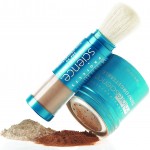Sun protection is necessary all year to protect the skin from UVA/UVB rays, but applying sunscreen throughout the day can be a pain—and wreck your makeup. Wouldn’t it be great to have a non-greasy product that could give you broad-spectrum protection without interrupting your daily schedule or interfering with your makeup?
 Sunforgettables is the first all-clear mineral powder sun protection with a broad-spectrum UVA/UVB protector. It comes in a brush/powder form and is easy to apply. There is no greasy residue or burning of eyes, and it is safe and effective for use on rosacea, eczema and acne.
Sunforgettables is the first all-clear mineral powder sun protection with a broad-spectrum UVA/UVB protector. It comes in a brush/powder form and is easy to apply. There is no greasy residue or burning of eyes, and it is safe and effective for use on rosacea, eczema and acne.
Not only is it safe for all skin types, including reactive skin, it can be applied immediately after laser treatments and peels. Sunforgettables will not generate heat so application even after the skin has reached erythema is safe.
Sunforgettables is composed of 12% micronized titanium dioxide, 12% micronized zinc oxide, and sea mineral, which distinctively protect the skin.
Why not protect your skin and look great doing it?
People often ask what anti-aging product will give them the best results. The answer? Sunscreen! You can spend hundreds of dollars on fancy moisturizers but, if you are not protecting your skin from UVA and UVB rays, your risk of premature aging and of developing pre-cancerous cells increases.
Sunscreen is not clearly understood. First, many people question why they need sunscreen in the winter when exposure to the sun is limited. The answer relates to the difference between UVA rays and UVB rays.
UVA rays are always present in full force, no matter what the season. They are so strong they can penetrate clothing and sunglasses and burn the skin on a cloudy day. The damage isn’t necessarily evident immediately but it’s there and can lead to premature aging, sun spots, deep wrinkles and “leathery” skin.
UVB rays burn the skin and increase your chance of developing skin cancer. Unlike UVA rays, they are stronger in the summer months and at high times such as the mid afternoon.
There is also much confusion regarding the SPF spectrum and what is necessary for sufficient protection. It is important to buy an SPF that has both UVA and UVB protection.
Generously apply a broad-spectrum, water-resistant sunscreen, and reapply it frequently. Apply sunscreen at least 30 minutes before direct UVA/UVB exposure. A second application should be applied half an hour to an hour after the first application because most people do not initially apply the appropriate amount. Always reapply sunscreen after swimming and sweating.
Remember, the number on the bottle of sunscreen does not represent the “strength” but the length of time you’re protected. For example, SPF 30 protects the skin 30 times more than using no sunscreen.
Many people in their professional lives suffer from the imposter syndrome—the belief that they are unworthy of the position they hold, do not have the necessary skills or education required for the job they do, and will lose their jobs as soon as the secret is out.
 A recent client underscored the depth of this problem and was particularly notable because of his impressive resume and his high position in a large oil company. Despite his laudable achievements, this gentleman suffered from crippling anxiety about his abilities. He suffered self-doubt and fear throughout his life, even as he continued to climb the corporate ladder to the top.
A recent client underscored the depth of this problem and was particularly notable because of his impressive resume and his high position in a large oil company. Despite his laudable achievements, this gentleman suffered from crippling anxiety about his abilities. He suffered self-doubt and fear throughout his life, even as he continued to climb the corporate ladder to the top.
It is true that we all have some self-doubt lurking in our minds, but the problem in this particular case goes beyond a nagging doubt concerning one’s capabilities. In this specific situation, the issue is of clinical import, causing distress in a person’s daily life. Indeed, it can be difficult to live life covertly, hiding away every day, living in fear, in threat of being found out, agonizing over losing one’s position or struggling with oneself over one’s perceived deficiencies.
From a superficial standpoint, what appears to be a simple maladaptive belief can, in fact, generate much turmoil in real life. Some examples of these repercussions:
- It can sap mental energy, leeching attention away from other important tasks, becoming a hindrance in getting things done.
- The person, because he is constantly insecure, has difficulty asserting himself, which in turn costs him respect and standing in the workplace.
- Constant second-guessing immobilizes a person so that he has difficulty making a decision.
- Heightened emotion resulting from self-doubt tends to cloud rational decision-making, costing the person advancement while costing the company money.
- Sustained, the problem tends to lead to dissatisfaction with employment.
- Sustained further, the situation can result in depression.
- Overall, the problem can lead to poor job performance that can cost the person his job and a further compounding of his already distorted self-worth.
- Having limited faith in his abilities, a person tends to become paranoid about others’ intentions and opinions of him. This tends to interfere with his work and creates problems in his personal life, as well.
- The situation can make it difficult to mix with others as an equal and, as such, it can impact a person’s ability to be part of a team, socialize, build relationships at work and get ahead.
- The problem can prevent a person from speaking up and contributing his point of view, which translates into lost talent for his company.
- The person feels demoralized because he has been unable to live up to his potential.
The issue, therefore, is more complex and sinister than might initially appear, and it comes with costs.
The underlying psychological issue is one of self-esteem. The gentleman I referred to earlier, despite his obvious success in his career, had suffered emotional distress because of this problem. The issue was finally resolved after he took action to deal with it. And that, in the end, turned out to be the true pinnacle of his achievement.
About the Author
Alexander is a Registered Psychologist specializing in addictions, depression, anxiety, stress, PTSD, stepfamily issues, chronic pain and self-esteem.
 Most parents know that good nutrition is important to fuel our children’s active minds and healthy growing bodies. But did you know this?
Most parents know that good nutrition is important to fuel our children’s active minds and healthy growing bodies. But did you know this?
When thinking about your children’s nutritional requirements, did you know that:
- Empty calories (e.g., candy and sweetened beverages) make up 20% of the total energy intake in Canadian school-aged children.
- 30% of Canadian children are not getting adequate calcium to support bone growth and development.
- 70% of school-age children in Canada do not get enough fruits and vegetables on a daily basis (Canadian Community Health Survey).
Surprised? Not to worry. Here are some simple and easy ideas to help you send your kids off with a healthy lunch. These tips may actually save you time!
- Respect the feeding relationship. It is your role as a parent to determine what, where and when food is offered. It is your child’s role to figure out what and how much to eat. Pressuring or bribing children to eat large amounts or certain disliked foods will make the whole experience unpleasant. Offer a healthy variety of food groups and trust your child to eat how much he or she needs to eat.
- Make food fun by getting them involved in the kitchen. Kids can help with food prep, sandwich building, cleaning up and wrapping. Don’t be afraid to involve them in meal planning. Let them pick one or two items from at least three different food groups.
- Make lunches the night before. You may find mornings a lot less hectic.
- Be ready for hunger to strike. Stock up on ready-to-eat fruits and vegetables such as carrot sticks, cherry tomatoes, berries and bananas at the beginning of the week. Buy individual yogurt containers, cheese strings and milk cartons.
- Plan ahead. Double up that dinner recipe and freeze some in individual containers. You’ve got homemade microwave lunches ready to go.
- Do not make any foods taboo. Aim for fewer treats, less often. In this way, you can teach your children where these foods fit in, and they will be able to make wise choices when they grow up.
Here are some healthier treat ideas that are great for school lunches:
Healthier snack mix
Instead of chips, mix plain popcorn with whole grain pretzels and cheese-flavoured whole grain crackers.
Fruit combo
Instead of a fruit roll up, mix fresh, cut up fruit with dried mangoes, cranberries, blueberries and cherries.
Sweet treat
Instead of chocolate-covered granola bars, offer low-fat chocolate milk or a mix of whole grain breakfast cereals with a few chocolate chips in an individual snack bag.
Finally, remember that parent modeling is one of the strongest predictors of children’s eating behaviours. So get crunching!
Material adapted from EatRight Ontario
If you or someone you know has osteoporosis, you should know that medication alone is not sufficient for the complete management of osteoporosis. Exercise is also necessary. A comprehensive program that includes strengthening the core musculature, hips and lower extremities is beneficial and decreases fragility.
Studies have shown that strengthening exercises for the major muscles groups combined with aerobic exercise has a small but positive effect on bone mass density in postmenopausal women with low bone mass density.
 When treating osteoporosis, the goal of the exercise program is to increase muscle strength safely, decrease immobility-related complications, and prevent fall and fracture. As with any exercise program, rehabilitation programs need to be individualized.
When treating osteoporosis, the goal of the exercise program is to increase muscle strength safely, decrease immobility-related complications, and prevent fall and fracture. As with any exercise program, rehabilitation programs need to be individualized.
Weight-bearing exercises such as walking are important for maintaining bone mass density. Strengthening the trunk muscles can improve bone mass density and the mobility of older adults, as well as decrease both excessive rounding of the back and the risk of fractures.
In men and women, the combination of age-related muscle loss and decline in physical activity can affect mobility and contribute to bone fragility and falls. Bone mass is frequently considered the most important determinant of fragility, but it explains less than half of the observed fracture risk. Many fractures are fall related, therefore the prevention of falls is as essential as increasing bone mass.
Studies have shown that even when exercise and rehabilitative measures do not increase bone mass, they can still be beneficial for reducing the occurrence of fractures, improving muscle imbalance and decreasing the risk of falls.
